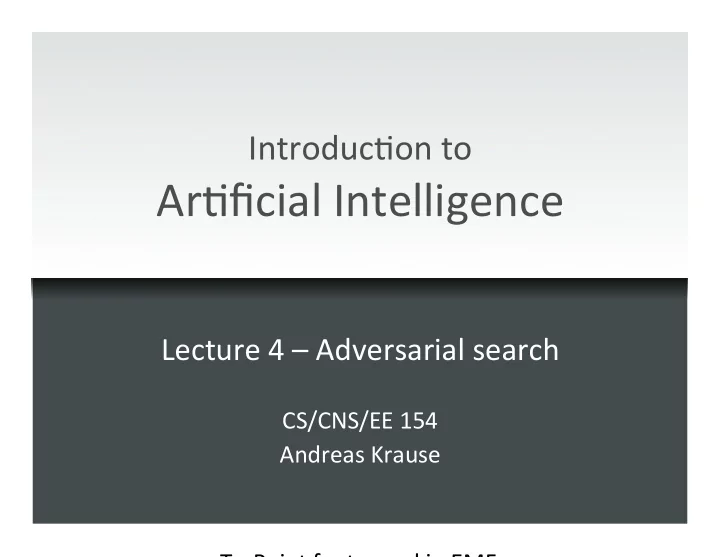

Introduc)on ¡to ¡ ¡ Ar)ficial ¡Intelligence ¡ Lecture ¡4 ¡– ¡Adversarial ¡search ¡ CS/CNS/EE ¡154 ¡ Andreas ¡Krause ¡ TexPoint ¡fonts ¡used ¡in ¡EMF. ¡ ¡
Projects ¡ � Recita)ons: ¡Thursday ¡4:30pm ¡– ¡5:30pm, ¡Annenberg ¡107 ¡ � Details ¡about ¡projects ¡ � Will ¡also ¡be ¡posted ¡on ¡webpage ¡ � By ¡Monday ¡10/11 ¡ � Form ¡team ¡of ¡3 ¡students ¡ � Need ¡to ¡select ¡project ¡(Doodle ¡link ¡will ¡be ¡sent ¡today) ¡ � For ¡independent ¡projects: ¡need ¡to ¡submit ¡proposal ¡ � If ¡you ¡don’t ¡have ¡a ¡team, ¡send ¡email ¡to ¡TAs ¡ � Homework ¡1 ¡out ¡on ¡Friday ¡ 2 ¡
Types ¡of ¡games ¡ Chess ¡ Backgammon ¡ Poker ¡ Rock ¡Paper ¡ WoW ¡ Scissors ¡ Observable? ¡ Determ.? ¡ Simultan.? ¡ Zero-‑sum? ¡ Discrete? ¡ # ¡Players? ¡ In ¡this ¡class, ¡focus ¡on ¡two-‑player, ¡sequen)al, ¡zero-‑sum, ¡ ¡ discrete ¡(mostly ¡determinis)c) ¡ 3 ¡
Games ¡vs. ¡search ¡ � In ¡games, ¡ac)ons ¡are ¡nondeterminis)c ¡ � Opponent ¡can ¡affect ¡state ¡of ¡the ¡environment ¡ � Op)mal ¡solu)on ¡no ¡longer ¡sequence ¡of ¡ac)ons, ¡ instead ¡a ¡strategy ¡(policy, ¡condi)onal ¡plan) ¡ � If ¡you ¡X ¡I’ll ¡do ¡Y, ¡else ¡if ¡you ¡do ¡Y ¡I’ll ¡do ¡Z, ¡…. ¡ 4 ¡
Game ¡tree ¡ 5 ¡
Minimax ¡game ¡tree ¡ � Search ¡for ¡op)mal ¡move ¡no ¡mafer ¡what ¡opponent ¡does ¡ � minimax ¡value ¡= ¡best ¡achievable ¡payoff ¡against ¡best ¡play ¡ 6 ¡
Solving ¡determinis)c ¡games ¡ � MiniMax ¡used ¡to ¡calculate ¡op)mal ¡move: ¡ � Induc)ve ¡defini)on: ¡ ¡ If n is terminal node: � Value is utility( n.state ) If n is MAX node: � Value is highest value of all successor node values If n is MIN node � Value is lowest value of all successor node values 7 ¡
Proper)es ¡of ¡minimax ¡search ¡ � Complete? ¡ � Time ¡complexity? ¡ � Space ¡complexity? ¡ � Op)mal? ¡ 8 ¡
α-‑β-‑pruning ¡ 9 ¡
α-‑β-‑pruning ¡ 10 ¡
α-‑β-‑pruning ¡ 11 ¡
α-‑β-‑pruning ¡ 12 ¡
α-‑β-‑pruning ¡ 13 ¡
α-‑β-‑pruning ¡ 14 ¡
α-‑β-‑pruning ¡ � Key ¡idea: ¡For ¡each ¡node ¡n ¡in ¡minimax ¡tree ¡keep ¡track ¡of ¡ � α: ¡Best ¡value ¡for ¡MAX ¡player ¡if ¡n ¡is ¡reached ¡ � β: ¡Best ¡value ¡for ¡MIN ¡player ¡if ¡n ¡is ¡reached ¡ � Never ¡need ¡to ¡explore ¡ ¡ consequences ¡of ¡ac)ons ¡ ¡ for ¡which ¡β<α ¡ � Avoid ¡exploring ¡“provably ¡ subop)mal” ¡parts ¡ ¡ of ¡minimax ¡tree ¡ 15 ¡
α-‑β-‑pruning ¡algorithm ¡ 16 ¡
Does ¡move ¡ordering ¡mafer? ¡ 17 ¡
Move ¡ordering ¡mafers ¡a ¡lot ¡ � Worst ¡case: ¡No ¡improvement ¡ � Best ¡case ¡(ideal ¡ordering): ¡ � Random ¡ordering: ¡ � How ¡to ¡find ¡a ¡good ¡ordering? ¡ 18 ¡
Large ¡state ¡spaces ¡ � Typical ¡branching ¡factor ¡in ¡chess: ¡35 ¡ � Compu)ng ¡the ¡complete ¡minimax ¡tree ¡is ¡intractable ¡ � Instead: ¡Cut ¡off ¡search, ¡and ¡replace ¡u)lity(s) ¡with ¡eval(s) ¡ � eval(s) ¡is ¡heuris)c ¡value ¡of ¡state ¡s ¡ 19 ¡
Developing ¡evalua)on ¡func)ons ¡ � This ¡is ¡where ¡expert ¡knowledge ¡comes ¡in ¡ � Typical ¡approach: ¡ � Select ¡features ¡f 1 ,…,f n ¡that ¡may ¡be ¡useful, ¡e.g., ¡value ¡of ¡ pieces ¡on ¡board, ¡posi)ons ¡of ¡pieces, ¡… ¡ � Learn ¡weights ¡from ¡examples ¡ � Deep ¡Blue ¡used ¡~6,000 ¡different ¡features! ¡ � Osen, ¡reinforcement ¡learning ¡is ¡very ¡useful ¡here ¡ ¡ (e.g., ¡TD-‑gammon ¡beats ¡world ¡champion ¡in ¡backgammon) ¡ 20 ¡
Problems ¡with ¡cutoff ¡search ¡ Black ¡to ¡move ¡ 21 ¡
Taming ¡the ¡horizon ¡effect ¡ � Quiescence ¡search ¡ � Evalua)on ¡func)on ¡also ¡evaluates ¡“stability” ¡(e.g., ¡strong ¡ captures, ¡etc.) ¡ � Cutoff ¡postponed ¡if ¡posi)on ¡is ¡unstable ¡ � Search ¡)me ¡no ¡longer ¡constant ¡ � Singular ¡extension ¡ � Search ¡deeper ¡if ¡a ¡node’s ¡value ¡is ¡much ¡befer ¡than ¡its ¡ siblings’ ¡ � Reduces ¡effec)ve ¡branching ¡factor ¡ � Can ¡search ¡much ¡longer ¡sequences ¡(even ¡30-‑40ply) ¡ ¡ 22 ¡
Playing ¡world ¡class ¡chess ¡ � Current ¡PCs ¡can ¡evaluate ¡~200 ¡million ¡nodes ¡/ ¡3 ¡min ¡ � Minimax ¡search: ¡~5 ¡ply ¡lookahead ¡ � With ¡α-‑β ¡pruning: ¡~10 ¡ply ¡ � Further ¡improvements: ¡ � Quiescence ¡search : ¡Only ¡evaluate ¡“stable” ¡posi)ons ¡ � Transposi/on ¡tables : ¡Remember ¡states ¡evaluated ¡before ¡ � Singular ¡extensions : ¡Expand ¡tree ¡if ¡there ¡is ¡singular ¡best ¡move ¡ � Null ¡move ¡heuris/c : ¡Get ¡lower ¡bound ¡by ¡leung ¡opp. ¡move ¡2x ¡ � Precompute ¡endgames ¡ (all ¡5, ¡some ¡6 ¡piece ¡posi)ons) ¡ � Opening ¡library ¡ (up ¡to ¡~30ply ¡in ¡first ¡couple ¡moves) ¡ � Hydra: ¡18 ¡ply ¡lookahead ¡(on ¡64 ¡processor ¡cluster) ¡ 23 ¡
Stochas)c ¡games ¡ � Two ¡“types” ¡of ¡uncertainty ¡ � Adversarial ¡and ¡stochas)c ¡ 24 ¡
Expec)MiniMax ¡tree ¡ 25 ¡
Solving ¡stochas)c ¡games ¡ � Expec)MiniMax ¡used ¡to ¡calculate ¡op)mal ¡move ¡ � Defined ¡induc)vely: ¡ ¡ If n is terminal node (or cutoff): � Value is utility( n.state ) (or eval( n.state )) If n is MAX node: � Value is highest value of all successor node values If n is MIN node � Value is lowest value of all successor node values If n is CHANCE node � Value is (weighted) average of all successor node values 26 ¡
Dealing ¡with ¡large ¡state ¡spaces ¡ � Backgammon: ¡ ¡ � 21 ¡possible ¡roles ¡with ¡2 ¡die; ¡~20 ¡legal ¡moves ¡ ¡ � #nodes ¡for ¡depth ¡4 ¡tree: ¡ � As ¡depth ¡increases, ¡reaching ¡any ¡par)cular ¡node ¡ becomes ¡exponen)ally ¡unlikely ¡ � Lookahead ¡becomes ¡less ¡valuable ¡ � α-‑β-‑pruning ¡much ¡less ¡useful: ¡world ¡just ¡won’t ¡play ¡along! ¡ � TD-‑gammon ¡compe))ve ¡with ¡best ¡human ¡players: ¡ � Uses ¡only ¡2 ¡ply ¡lookahead! ¡ � But ¡very ¡carefully ¡trained ¡evalua)on ¡func)on ¡ 27 ¡
Recommend
More recommend